October 1, 2016
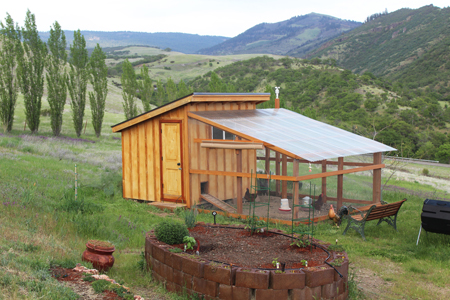 Chicken Fortress
Chicken Fortress
PREDATOR PROOF CHICKEN COOP
By Dorothy Ainsworth
A safe hen is a happy hen. I wanted our chickens to be stress-free, not having to worry about anything but strutting around, gossiping, pecking away, taking dirt baths, and laying eggs, so I set out to build a PREDATOR PROOF coop.
 Piers and posts
Piers and posts
 Framing lumber and sheathing
Framing lumber and sheathing
 Level and square
Level and square
Framing the coop
It's almost as much trouble to construct a make-shift coop as a standard stud-frame shed-style coop, so I went for the latter. I designed a simple 8' x 8' structure framed with 2" x 4"s, and the roof with 2" x 6"s. The floor sits on 12 bracketed piers with four on one side and three on the other. The piers are connected by PT (pressure-treated) 4"x 4"s set in the brackets and screwed down. I fastened 2" x 6" x 8-foot Doug Fir boards across those 4" x 4"s for a sturdy floor.
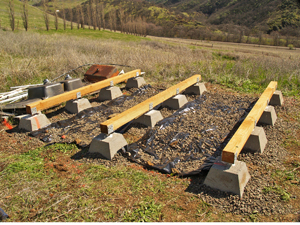 Foundation
Foundation
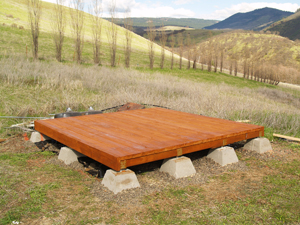 Floor 8 ft. x 8 ft.
Floor 8 ft. x 8 ft.
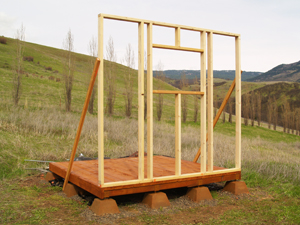 Front wall frame
Front wall frame
 Back wall ready to go up
Back wall ready to go up
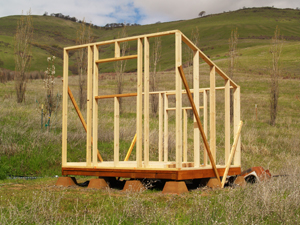 Three walls up
Three walls up
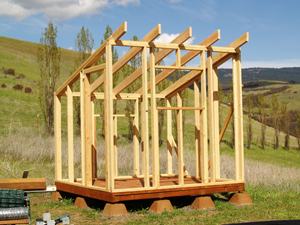 Rafters up
Rafters up
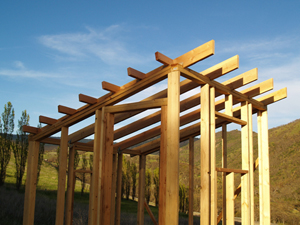 "Outboard" rafters to support side overhang
"Outboard" rafters to support side overhang
 Framing complete
Framing complete
I sheathed the framing inside and out (as well as the roof) with 4' x 8' sheets of 7/16" OSB——and insulated the entire structure with R-13 fiberglass batts. I built the roof with an overhang all the way around, not just front and back, and roofed with rolled roofing, quick and easy——and cheap. After the coop was finished I put down removable/replaceable OSB——on top of the 2" x 6" floor boards because chickens are messy.
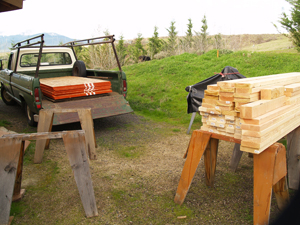 OSB sheathing in truck
OSB sheathing in truck
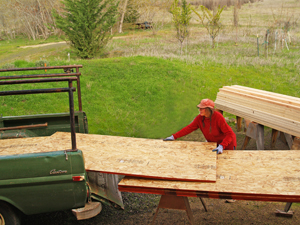 Unloading sheathing solo
Unloading sheathing solo
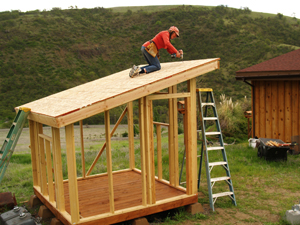 Fastening OSB on roof
Fastening OSB on roof
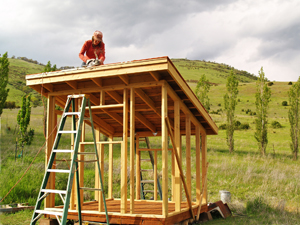 Trimming OSB flush
Trimming OSB flush
Note: Common dimensional lumber is still incredibly inexpensive——an 8-foot 2" x 4" is only about three bucks, same as it was many years ago.
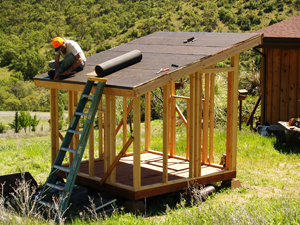 Tarpaper on roof
Tarpaper on roof
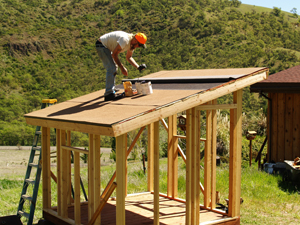 Rolled roofing w/tarred seams
Rolled roofing w/tarred seams
 Happy the roof is almost done
Happy the roof is almost done
 Sheathing complete
Sheathing complete
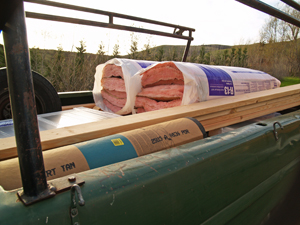 R-13 insulation
R-13 insulation
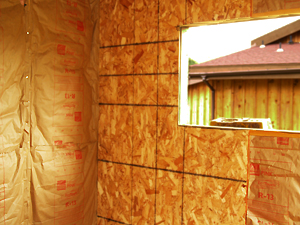 Insulation installed
Insulation installed
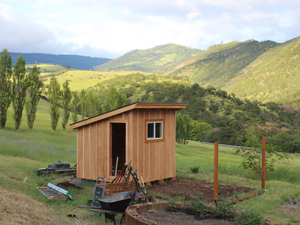 Beautiful spring day
Beautiful spring day
Siding and windows
To match the board and batten house near by, I sided the whole thing with 4' x 8' x 3/8" Breckenridge mahogany plywood. It was $17/sheet, but worth it. I used fir 1" x 3"s for battens, and sprayed (with a garden sprayer) the entire structure with Natural Super Deck water-based stain (no petroleum fumes, thank you).
Then I put the two windows in (on sale from Home Depot) a 2' x 3' window in front, facing south for sunshine, and a 1' x 3' window in back, facing north, for cross-ventilation.
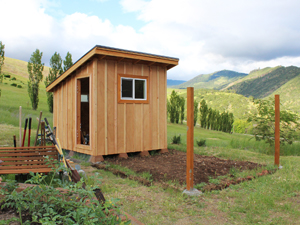 Corner posts set
Corner posts set
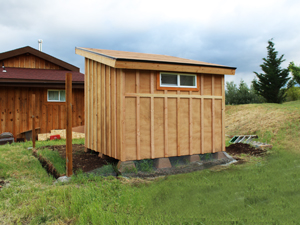 Rearview
Rearview
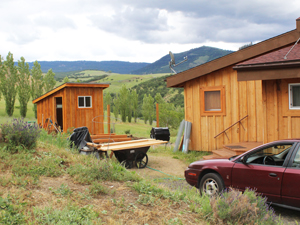 Overview of coop and house
Overview of coop and house
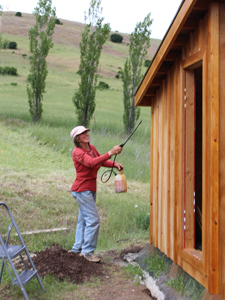 Spraying stain on siding
Spraying stain on siding
Note: Chickens require A LOT of light and fresh air to be healthy and to keep laying into the fall. (Then they take a much-deserved winter break.)
The chicken run and hardware cloth
Next came the hard part: I dug deep holes (4'-5' apart) to set equally-spaced 4" x 4" x 8-foot PT posts around the 10' x 12' south-facing chicken run and another strip of yard on the east side for afternoon shade in the summer. I made sure the posts were plumb and cemented them in.
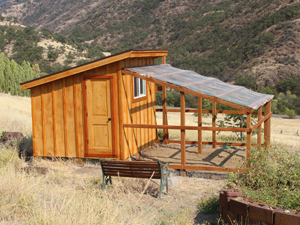
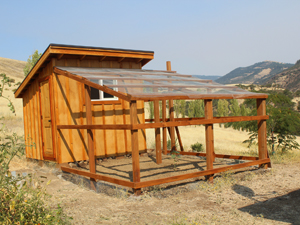 Framed-in chicken run
Framed-in chicken run
I then fastened three 2" x 4" x 12-foot rafters across the tops of the vertical posts, and four purlins across those (perpendicular to the rafters), so there would be plenty of support for the hardware cloth overhead, which I wired to the hardware cloth on the sides.
I also wanted enough cross members on the "roof" to be able to fasten transparent awning panels on top for protection from rain and snow, and keep the dirt in the run from turning to mud. In the fall I planted the run with grass seed to help with that problem, and also provide greens for the chickens.
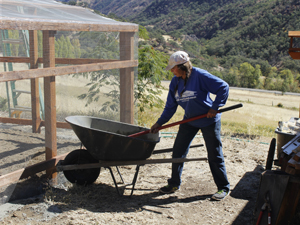

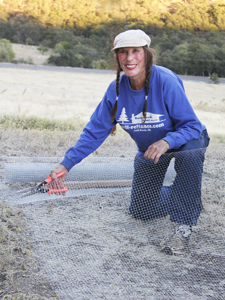 Cutting hardware cloth w/metal shears
Cutting hardware cloth w/metal shears
Then I dug a narrow but 16"-deep trench around the perimeter of the run between the vertical posts, and laid a wide strip of hardware cloth on edge in it. I poured concrete in the trench using 60 lb. bags of Quikcrete——mixing one bag at a time in the wheelbarrow with a hoe, and filling the trench halfway up. I left the strip sticking up several inches so I could wire the "walls" of hardware cloth to it as I enclosed the entire run.
Hardware cloth comes in 48" x 25-foot rolls which I rolled out in two 48" wide courses to go on horizontally and cut them to length with a metal shears. I overlapped the seams and stapled them down to the horizontal 2" x 4"s with a manual hammer-tacker.
Warning: Be careful to pick up errant staples or the chickens might eat them.
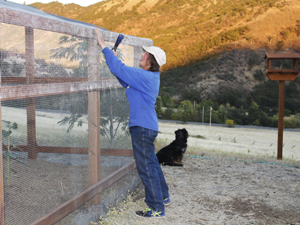 Stapling hardware cloth to frame
Stapling hardware cloth to frame
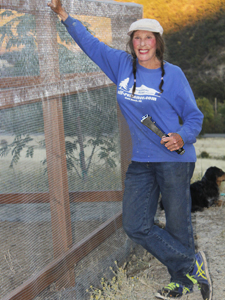 Hammer-tacker tool (manual)
Hammer-tacker tool (manual)
When the cloth was on the sides, I filled the trench with concrete the rest of the way up, and level with the ground.
(Why something that stiff, and prickly enough to draw blood, is called "cloth", I'll never know.)
Foiling predators
We have eagles, hawks, and owls that would love a fat hen for lunch, hence the hardware cloth ROOF.
No common predators (except bears) are strong enough to rip through the ½" grid of galvanized steel hardware cloth, but they can surely rip and chew through chicken wire. I've lost a lot of chickens by using ¾ poultry netting, even when I've put it UNDER the coop and the run as well as doubling it on the sides and top.
The list of predators sneaky enough to get your chickens are: dogs, coyotes, cougars, bobcats, house cats, foxes, raccoons, weasels, skunks, and opossums. You have to outsmart them, and hardware cloth is the trick.
The door and gate
I found an attractive 26" wide door for $25 at the local "Builder's Bargain Center", trimmed the length off a few inches to fit the doorway, and installed it with three self-closing hinges and a secure lockset. The only two places a masked bandit (Mr. Raccoon) could sneak in would be through the door or the back gate entrance to the yard, if either was left ajar.
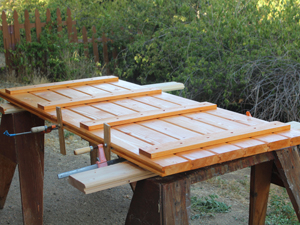 Building T&G gate w/battens across
Building T&G gate w/battens across
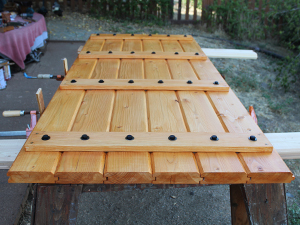 Gate complete w/battens bolted on
Gate complete w/battens bolted on
I built the gate out of T&G DF (tongue & groove Douglas Fir) and bolted it together with battens. Midway up it has a gate latch, and at the bottom on the outside, a slider bolt that holds it tightly against the doorjamb's 1x2 "stop".
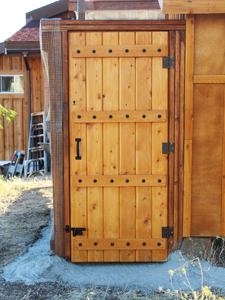 Back gate installed
Back gate installed
 Inside view of back gate
Inside view of back gate
Because the coop is so secure, I can leave the 12" x 12" square hole open where the girls can come and go as they please in and out of the coop. I was going to buy an automatic solar-powered "Cluck-O-Matic" or "Cheeper-Keeper"——fantastic inventions that open and close the door at dawn and dusk——but now I won't need one.
Inside the coop
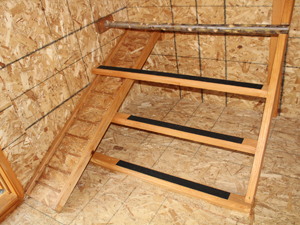 Roosting bar
Roosting bar
On the low north wall in the back of the coop, I built an ascending ladder out of 2" x 4"s up to the roosting bar. The roosting bar is a 2" dia. round branch set 12" out from the wall and 3-feet off the floor, which is about a foot below the window. I'll close the window in winter, but keep it open in summer for cross-ventilation. Both windows are protected with hardware cloth.
I'll hang a small heat lamp in the coop on the coldest nights, but it's not healthy to keep chickens unseasonably warm——it's best if they adapt.
Like their ancestors sleeping in trees in the wild, chickens prefer a 1.5" to 2" rounded branch to roost on at night because the flexor tendons in their legs and feet lock them safely on the perch while they sleep. Instinctively they like to roost as high off the ground as possible, but the low end of the shed roof prevented me from putting the bar any higher than three feet.
Note: The roost should always be higher than the nesting boxes or they'll sleep in the boxes.
Chickens continue to poop even while asleep, so it's advisable to put lots of extra sawdust and straw below the roost.
In addition to the ladder, I put a little ramp (made from a BCI joist) up to the roosting bar just in case the pampered hens don't want to take the "stairs".
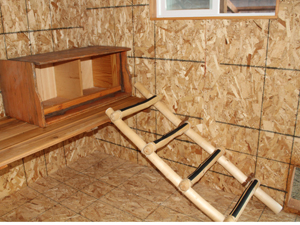 Nesting boxes
Nesting boxes
On the east side I built two 12" x 12" nesting compartments in an old pine box and fastened it on a cedar board platform two feet off the floor. I put a cute little ladder (from Goodwill) up to the nesting boxes, and glued grip-tread on the smooth rungs so the girls won't slip as they hop up and then down.
The floor inside will be covered with coarse sawdust, pine shavings, and straw, and in the middle will be their water, chicken scratch, oyster shells, and laying mix.
Choosing chickens
Come spring, three or four lucky ladies will have it made in the shade in their $1000 fortress. We'll probably buy Rhode Island Reds from the Grange or from Craigslist because they are colorful, tough and hearty, and prolific layers of beautiful brown eggs.
There are many breeds of chickens to choose from, including another one of our favorites because they lay pastel blue and green "Easter" eggs and have a lot of personality: Araucanas.
It's fun to raise a clutch of chicks, but it's hard to know what sex they are when they're that tiny, so we may buy "teenagers". We don't want to take a chance on getting all roosters! The important thing is to get a brood of hens that already know each other and get along. Newcomers are picked on and pecked on.
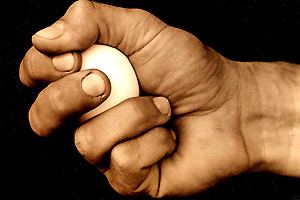
The incredible egg
Not only do chickens entertain us with their antics and delightful sounds, but their eggs are considered a SUPERFOOD. An egg is a complete little meal in a shell——only 70 calories, no carbs, no sugar——and is full of vitamins, minerals, and protein. Here's a list of what an egg contains:
- 6 grams of protein with all 9 essential amino acids
- A good source of choline, selenium, lutien, zeaxanthin, phosphorous, riboflavin, calcium, zinc, molybdenum, iodine, iron, and caratenoids
- Vitamins A, D, E, K, B1, B2, B3, B5, B6, B9, B12
Contrary to popular belief, the fat in the yolk actually raises the good cholesterol ratio (HDL) in most people.
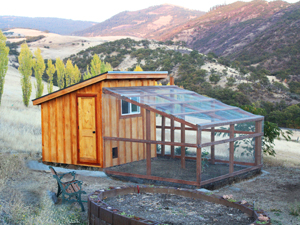 Overview of the country setting
Overview of the country setting
Closing thoughts
Considering how nourishing eggs are, it would behoove anyone preparing for a possible survival situation——or just for self-reliance on a daily basis——to keep a few a backyard chickens in a coop with a modest run, even in a city. Hens are quiet enough to live in town, but there's no good way to silence a rooster. (I said good way!) They make great alarm clocks——but unfortunately there's no snooze button!
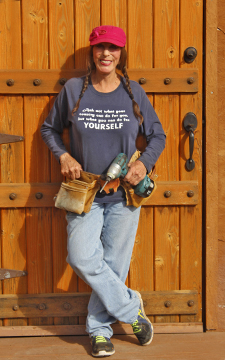 Yours truly, 74, and still at it
Yours truly, 74, and still at it
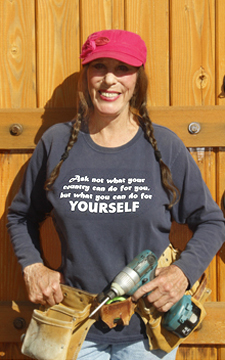 My favorite T-shirt
My favorite T-shirt (Sadly missing is my
"Make America Great Again" hat.)
